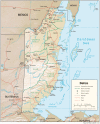Cancer Demographics and Time-to-Care in Belize
- PMID: 36928719
- PMCID: PMC10243772
- DOI: 10.1093/oncolo/oyad030
Cancer Demographics and Time-to-Care in Belize
Abstract
Background: Belize is a middle-income Caribbean country with poorly described cancer epidemiology and no comprehensive cancer care capacity. In 2018, GO, Inc., a US-based NGO, partnered with the Ministry of Health and the national hospital in Belize City to create the first public oncology clinic in the country. Here, we report demographics from the clinic and describe time intervals to care milestones to allow for public health targeting of gaps.
Patients and methods: Using paper charts and a mobile health platform, we performed a retrospective chart review at the Karl Heusner Memorial Hospital (KHMH) clinic from 2018 to 2022.
Results: During this time period, 465 patients with cancer presented to the clinic. Breast cancer (28%) and cervical cancer (12%) were most common. Most patients (68%) presented with stage 3 or 4 disease and were uninsured (78%) and unemployed (79%). Only 21% of patients ever started curative intent treatment. Median time from patient-reported symptoms to a biopsy or treatment was 130 and 189 days. For the most common cancer, breast, similar times were seen at 140 and 178 days. Time intervals at the clinic: <30 days from initial visit to biopsy (if not previously performed) and <30 days to starting chemotherapy.
Conclusion: This study reports the first clinic-based cancer statistics for Belize. Many patients have months between symptom onset and treatment. In this setting, the clinic has built infrastructure allowing for minimal delays in care despite an underserved population. This further affirms the need for infrastructure investment and early detection programs to improve outcomes in Belize.
Keywords: Belize; Caribbean; cancer; delays; social determinants.
© The Author(s) 2023. Published by Oxford University Press.
Conflict of interest statement
The authors indicated no financial relationships.
Figures




Similar articles
-
Assessment of Cervical Cancer Prevention and Treatment Infrastructure in Belize.JCO Glob Oncol. 2021 Aug;7:1251-1259. doi: 10.1200/GO.21.00138. JCO Glob Oncol. 2021. PMID: 34351814 Free PMC article.
-
Cost-effectiveness of HPV vaccination in Belize.Vaccine. 2015 May 7;33 Suppl 1:A174-81. doi: 10.1016/j.vaccine.2014.12.042. Vaccine. 2015. PMID: 25919158
-
Belize.Backgr Notes Ser. 1987 Aug:1-6. Backgr Notes Ser. 1987. PMID: 12177958
-
Characterizing participants in the North Carolina Breast and Cervical Cancer Control Program: A retrospective review of 90,000 women.Cancer. 2021 Jul 15;127(14):2515-2524. doi: 10.1002/cncr.33473. Epub 2021 Apr 7. Cancer. 2021. PMID: 33826758 Free PMC article. Review.
-
Health-Related Quality of Life in Patients with Breast Cancer in Latin America and the Caribbean: A Systematic Review and Meta-Analysis.Oncologist. 2021 May;26(5):e794-e806. doi: 10.1002/onco.13709. Epub 2021 Feb 25. Oncologist. 2021. PMID: 33554426 Free PMC article.
References
-
- Bank W.Accessed July 4, 2022. https://www.worldbank.org/en/country/belize
-
- Health Mo. Ministry of Health Belize Health Sectore Strategic Plan 2014–2024 . https://extranet.who.int/nutrition/gina/en/node/39409
-
- WHO. PAHO/WHO Country Cooperation Strategy Belize 2017–2021 . https://www.paho.org/en/documents/pahowho-country-cooperation-strategy-b...
Publication types
MeSH terms
Grants and funding
LinkOut - more resources
Full Text Sources
Medical

